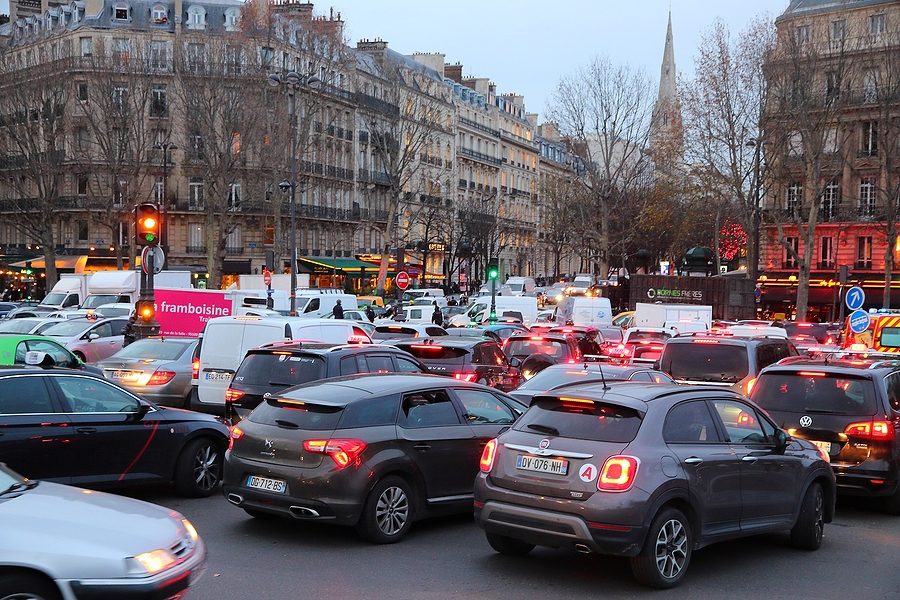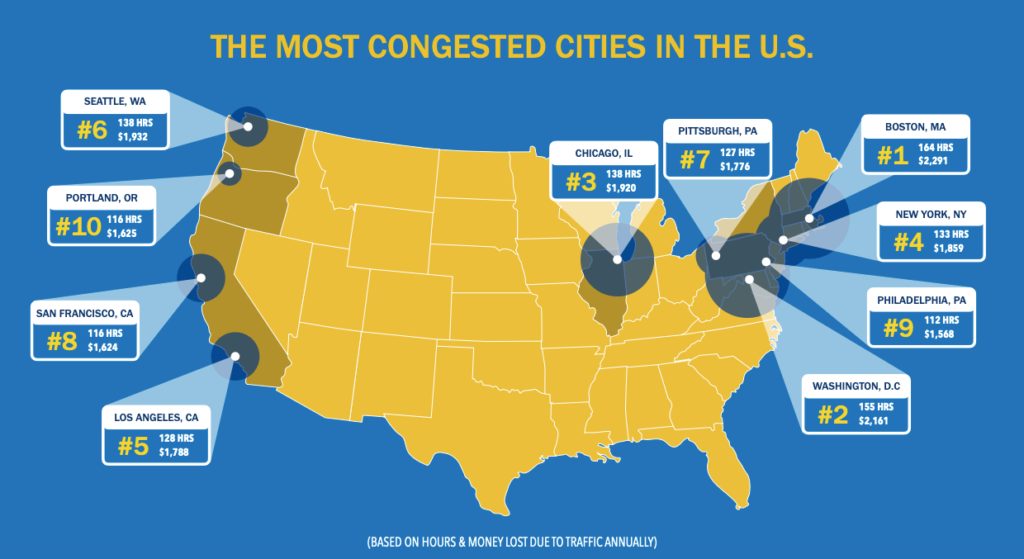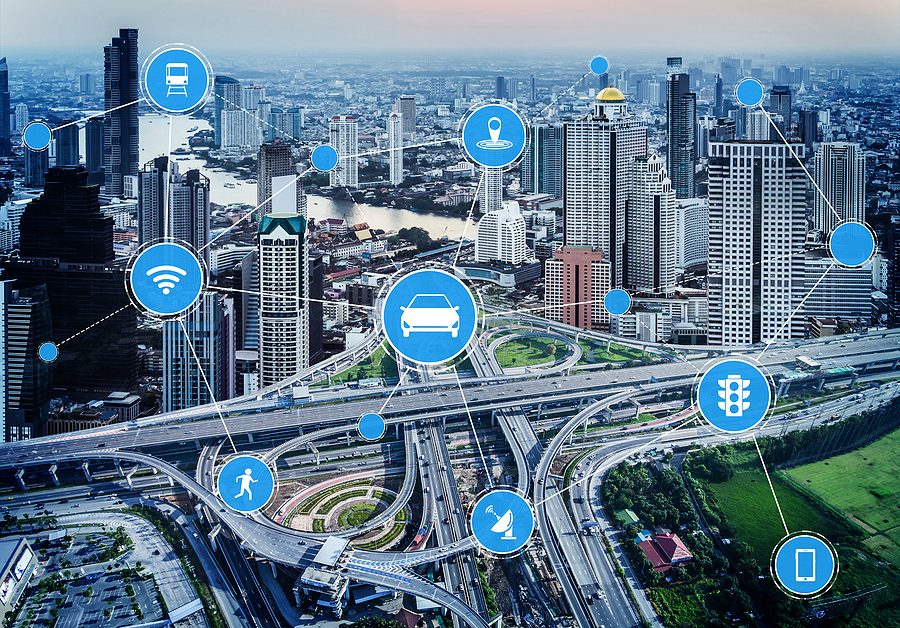Traffic is a headache for all city commuters. How can Smart Cities increase mobility while eliminating congestion? Read our Trends blog for the answer.
- Causes of Traffic Congestion
- How does traffic congestion affects the economy?
- Reducing Traffic Congestion in Urban Areas
- Traffic Congestion Solutions
- Stefanini’s Smart Solutions for Cities

Have you ever found yourself stuck in a traffic jam on the way to work? If you’re a driver, you likely have. And traffic is undoubtedly the most frustrating part of any commute. So, what causes traffic and how can we eliminate it to improve the quality of urban living? Read on for the answer.
Causes of Traffic Congestion
When it comes to urban environments, traffic management can certainly be one of the biggest factors negatively affecting city life. With bad traffic, of course, comes a delay in travel time. According to the U.S. Department of Transportation, congestion usually relates to an excess of vehicles on a portion of roadway at a particular time, which results in speeds that are slower than normal or “free flow” speeds. What is the cause of these delays and how can we work around them?
The Department of Transportation cites seven sources, which are grouped into three broad categories:
Category 1 – Traffic-Influencing Events
1) Traffic Incidents
Any events that disrupt the normal flow of traffic count as traffic incidents – specifically those that physically impede traffic lanes. These can include events like vehicle breakdowns, crashes, and debris in travel lanes. Additionally, events that occur on the roadside or shoulder can influence traffic flow by distracting drivers, leading to changes in driver behavior and ultimately lessening the quality of traffic flow. Distracting traffic incidents that occur off the roadway can also affect travel in the travel lanes.
2) Work Zones
You’ve likely driven along roads that have been under construction and are familiar with the slowdowns these can cause. Any construction activities on the roadway that cause physical changes to the highway environment can result in significant congestion. These changes may include lane “shifts,” a reduction in the number or width of travel lanes, lane diversions, reduction, elimination of shoulders and temporary roadway closures. Delays caused by work zones have been cited by drivers as one of the most frustrating conditions they encounter while traveling.
3) Weather
Environmental changes can affect traffic flow by leading to changes in driver behavior. When precipitation, bright sunlight on the horizon, fog, or smoke are present, drivers will usually lower their speeds and increase their headways due to reduced visibility. Even after precipitation has ended, wet, snowy, or icy roadway surface conditions will also lead to the same effect.
Category 2 – Traffic Demand
1) Fluctuations in Normal Traffic
If you commute to work, you’re no stranger to rush hour. Day-to-day variability in demand leads to some days or times with higher traffic volumes than normal.
2) Special Events
During special events like sporting events, demand fluctuations where traffic flow near the event will be radically different from “typical” patterns. Special events occasionally cause surges in traffic demand, which overwhelms the system.
Category 3 – Physical Highway Features
1) Traffic Control Devices
Control devices such as railroad grade crossings and poorly timed signals cause intermittent disruption of traffic flow, ultimately contributing to travel time variability and congestion.
2) Physical Bottlenecks (“capacity”)
The physical “capacity” of roadways refers to the maximum amount of traffic capable of being handled by a given highway section. A number of factors determine capacity, including: merge areas at interchanges; the number and width of shoulders and lanes; and roadway alignment (grades and curves). A special case of bottlenecks can also include toll booths, as they restrict the physical flow of traffic. Another factor that is difficult to determine includes driver behavior. Research has shown that drivers who are familiar with routinely congested roadways space themselves closer together than drivers on less congested roadways, leading to an increase in the amount of traffic that can be handled.
Traffic Congestion and the Economy
Though one may not think to link traffic congestion and the economy, research shows that traffic congestion cost the United States economy nearly $87 billion in 2018.
Transport data company INRIX looked into the state of congestion in 200 cities in 38 countries to examine how much money and time traffic wastes. In the US, it found that total cost of lost productivity caused by congestion to be $87 billion.

In terms of lost hours, the three worst cities in the US for motorists are Chicago, Boston, and Washington DC. Traffic caused the average Bostonian driver to lose 164 hours in 2017, which cost the local economy $4.1 billion. In Washington it was 155. In third place, with 138 lost hours, was Chicago, while for New York it was 133 and 128 in Los Angeles.
It’s no surprise that the two older cities, established long before the invention of the automobile and therefore lacking the proper infrastructure to support vehicular transportation, are the cities with the worst congestion. Meanwhile, in Europe, the most congested city is Rome.
Roughly 55 percent of the world’s population live in urban areas, which is expected to rise to 68 percent by 2050. Unfortunately, current transportation systems aren’t built to cope with future demand without increasing pollution and congestion.
As it tries to find a viable solution to this problem, the World Economic Forum’s Global Future Council on Cities and Urbanization is looking for smart and sustainable city solutions and projects that are repeatable and scalable, so it can bring them to the attention of worldwide city governance.
Reducing Traffic Congestion in Urban Areas
Smart Cities may be the answer that urban areas are looking for. Increasingly, the public sector is looking to the private sector for creative, cost-saving solutions to complex transportation problems, which can result in intelligent transportation systems. Although the INRIX study did not look at China, there are some lessons the world’s second largest economy can teach us. Home to around eight million people, with as many as 23 million in its greater metropolitan area, Hangzhou used to be one of China’s most congested cities. But, when it comes to traffic, it’s dropped from fifth to 57th, not because there are more roads or fewer cars, but because the city’s traffic system is AI-assisted.
The town’s transport officials are using a tool called Hangzhou City Brain to constantly manage and monitor the flow of traffic by making adjustments to traffic lights and signage in response to real-time needs. It is powered by a combination of big data, IoT, and machine learning, with much of the technology provided by tech giant, Alibaba.
Traffic in Hangzhou now moves 11 percent faster than it used to and the time taken by emergency services vehicles to respond to calls for help has been halved. McKinsey believes commuting times could be cut by up to 20% with this type of smart city technology.
Traffic Congestion Solutions

Reduced congestion has become such an attention-grabbing issue for city officials cities around the world that by 2020, they are slated to spend $41 trillion on smart city technology.
According to the Smart City Council, using WiFi and the Internet of Things (IoT), a Smart City uses the open data it gathers to make the city more livable, enjoyable, and that are energy efficient. Cities will be able to implement various systems to address traffic congestion like vehicle-to-vehicle (V2V) communication and vehicle-to-infrastructure (V2I) communication.
The following are four astounding smart city technologies that are reducing traffic congestions in large cities:
1) Adaptive Traffic Signals
V2I is doing a lot of work to make traditional traffic signals smarter and more efficient. Cities like Columbus, Ohio are using data gathered by government vehicles to improve the timing of traffic lights located throughout the city. Government fleets are outfitted with individual devices that collect and transmits the speed, movement, and other data points from individual government cars driving throughout the city. This information is then analyzed and its data points are used as part of the city’s smart city project. This program is giving city officials valuable, detailed insight on how long vehicles are idling at traffic lights. This information can be used to make travel in Columbus more environmentally sustainable and efficient.
2) Real-Time Traffic Feedback
Creating a sustainable public transportation system is a formidable task. In Kansas, a large project is being developed with free streetcars that carry more than 6,200 passengers a day between significant business districts. The system relies on real-time traffic feedback that helps streetcars choose the best route and maximize their use by citizens, which allows citizens to know exactly where the streetcars are and how long they will take to reach certain destinations, like parking lots.
3) Pedestrian Tracking Systems
Pedestrian traffic is just as important to manage as vehicular traffic. Cities like Las Vegas are using advanced V2I technologies to track how many vehicles pass throughout an intersection at different times. Further, they can see how many pedestrians cross the street. This information can help city planners find patterns in pedestrian traffic so they can time lights or shift traffic flow to less populated areas of the city if needed. This increases all travelers’ efficiency and makes crossing busy streets safer for all.
4) V2I Smart Corridors
Drivers need roadways that can provide real-time feedback and guidance. These intelligent roadways can be found in states like Wyoming, which is using V2I technologies to help cars and trucks pass hazardous and congested areas safely. The state is using V2I technology to send road and safety-related weather alerts to drivers who sign up for the program. With 75 short-range communication devices situated in points of interest, drivers are able to receive life-saving information. As a result, officials expect to see a significant positive impact on the local economy and overall safety among travelers in the area.
Stefanini’s Smart Solutions for Cities
Reducing traffic congestion overwhelmingly can improve quality of life. Yet, with technologies like the above, we can create commutes that are faster, safer, improve air quality, and public safety.
At Stefanini, we provide excellence in Smart City Initiatives, with a focus on the people who visit, live, and operate within these cities. Our expertise includes Industry 4.0, Cyber Security, Cognitive, Customer Experience (CX), and more. We offer automation and Artificial Intelligence (AI) solutions to bolster productivity as well as User Experience (UX) support. At the end of the day, innovation and digital transformation are the main pillars of Smart City deployments; we are here to help you with that process.
Contact us today to learn how we can make your city smarter and better-connected!
Related articles:



















